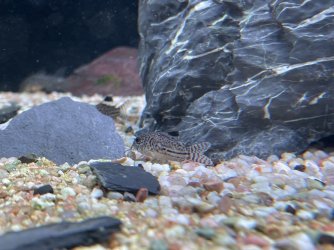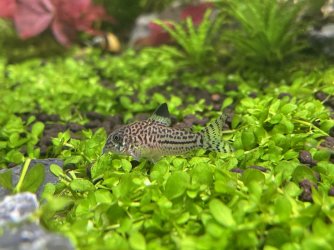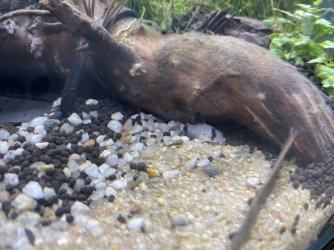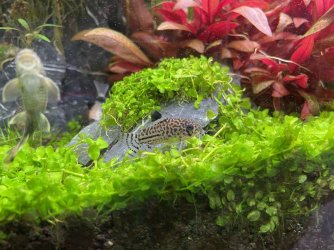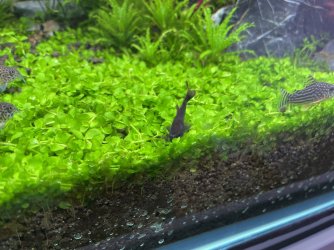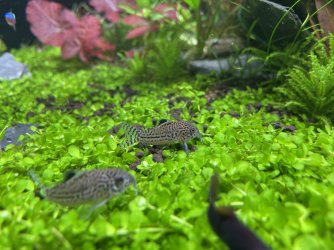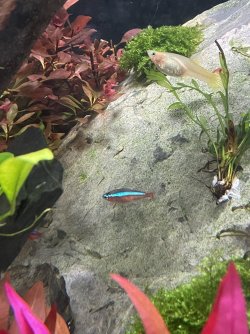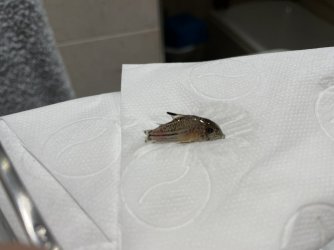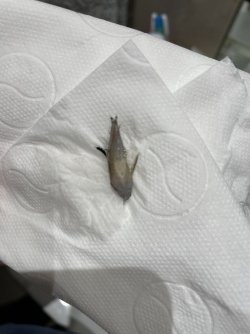Before start with the problem, I will post the main tank information.
Tank
Current Stock
Maintenance:
Water Chemistry - Since I introduced fish, ammonia are always 0, nitrite 0 and nitrate 5 during nigth ate the end of the day (reach 10 after add ferts).
PH - 6,6
KH - 3
GH - 5
Since, my plants eats lot of nitrate, I need to dose Tropica Specialized when Nitrate are 0. Since Tropica Specialized has nh4no3 (ammonium nitrate), when I dose the week dose (20 Pumps), I have NH4 0,25 for 2 hours, and 0,15-0,2 nitrite 6h before all reach 0 again.
Now, the problem. All my Corydoras are acting strange, with a pale or skin deformation and fin rot.
My last introduction was 4 black Venezuela Corydoras and 10 Sterbei 2 weeks ago. I have made an mistaking during the acclimatisation of the Black Corydoras, because the plastic bag drawn a little, and some water of the bag mix with water of my tank.
One day after the introduction of black Corydoras, one of them died (first stoped on the bottom and before died, started to swimming in circles and spinning without direction). 3 days after this, all my active Corydoras started to lay down on the bottom, most of the time, and only active during feeding or right after a water change.
After this, I stay alert and observing the corys everyday. No sign of fin rot, skin problems, white spots or cotton, but 1 week later (3 days ago), lost one Julli. Again, no sign of any strange external problem, and only missing color (or skin) between gill and fin, but could be eaten by the Amano shrimp.
Yesterday, I have spotted the first external sign, 1 julli with strange side skin, seems all scales are jumping.
Today, I have spotted one Cory Panda, with fin rot and strange side skin also.
When I look to my corys, I have different signs, some seems red belly, other pale or strange skin.
I took some photos, and ask some help in one lfs, and the say to dose Myxazin, and apply only to sick fish on other tank.
Through this path, I lost two Otocinclus, but I don't relate with this, because my lfs told me this fish starving without algae and some don't eat pellets and die. My tank don't have a lot of algae right now, and I have to start to feed ancistrus with zucchini because they start to eat some plants.
So, all other fish and shrimp (except maybe for Otocinclus), are fine without signs of feeling bad.
Before start to dose meds, as sugested by lfs, I want to know your opinion.
Note: One black Venezuela has a white mark in the head.
Some pictures attached.
Videos:
Tank
- 170cm long x 50 cm wide x 60 cm tall
- 510L
Current Stock
- 5 Guppy Endler
- 5 Guppy
- 15 Tetra Cardinal
- 6 White Fin Tetra
- 10 Black ghost Cardinal
- 2 Ancistrus
- 10 Otocinclus (already lost 2)
- 10 Corydoras Sterbei
- 10 Corydoras Julli (already lost 1)
- 6 Corydoras Panda (already lost 1)
- 3 Corydoras Black Venezuela (already lost 1)
- 1 Garra Flavatra
- 20 Amano Shrimp
- 20 Red Cherry Shrimp
Maintenance:
- During 1st mouth - 60% water Change every other day
- Next 2 weeks - 60% wc every two days
- Next 2 weeks - 60% wc even 2x week
- After 2 months until now - 60% wc 1x week
- Never clean my bio media (sachem Matrix) and 1 bag Seachen Purigen, to avoid lose beneficial bacteria in the first months
- Cleaning Pre Filter Sponges every other week
Water Chemistry - Since I introduced fish, ammonia are always 0, nitrite 0 and nitrate 5 during nigth ate the end of the day (reach 10 after add ferts).
PH - 6,6
KH - 3
GH - 5
Since, my plants eats lot of nitrate, I need to dose Tropica Specialized when Nitrate are 0. Since Tropica Specialized has nh4no3 (ammonium nitrate), when I dose the week dose (20 Pumps), I have NH4 0,25 for 2 hours, and 0,15-0,2 nitrite 6h before all reach 0 again.
Now, the problem. All my Corydoras are acting strange, with a pale or skin deformation and fin rot.
My last introduction was 4 black Venezuela Corydoras and 10 Sterbei 2 weeks ago. I have made an mistaking during the acclimatisation of the Black Corydoras, because the plastic bag drawn a little, and some water of the bag mix with water of my tank.
One day after the introduction of black Corydoras, one of them died (first stoped on the bottom and before died, started to swimming in circles and spinning without direction). 3 days after this, all my active Corydoras started to lay down on the bottom, most of the time, and only active during feeding or right after a water change.
After this, I stay alert and observing the corys everyday. No sign of fin rot, skin problems, white spots or cotton, but 1 week later (3 days ago), lost one Julli. Again, no sign of any strange external problem, and only missing color (or skin) between gill and fin, but could be eaten by the Amano shrimp.
Yesterday, I have spotted the first external sign, 1 julli with strange side skin, seems all scales are jumping.
Today, I have spotted one Cory Panda, with fin rot and strange side skin also.
When I look to my corys, I have different signs, some seems red belly, other pale or strange skin.
I took some photos, and ask some help in one lfs, and the say to dose Myxazin, and apply only to sick fish on other tank.
Through this path, I lost two Otocinclus, but I don't relate with this, because my lfs told me this fish starving without algae and some don't eat pellets and die. My tank don't have a lot of algae right now, and I have to start to feed ancistrus with zucchini because they start to eat some plants.
So, all other fish and shrimp (except maybe for Otocinclus), are fine without signs of feeling bad.
Before start to dose meds, as sugested by lfs, I want to know your opinion.
Note: One black Venezuela has a white mark in the head.
Some pictures attached.
Videos:
Attachments
Last edited by a moderator:

